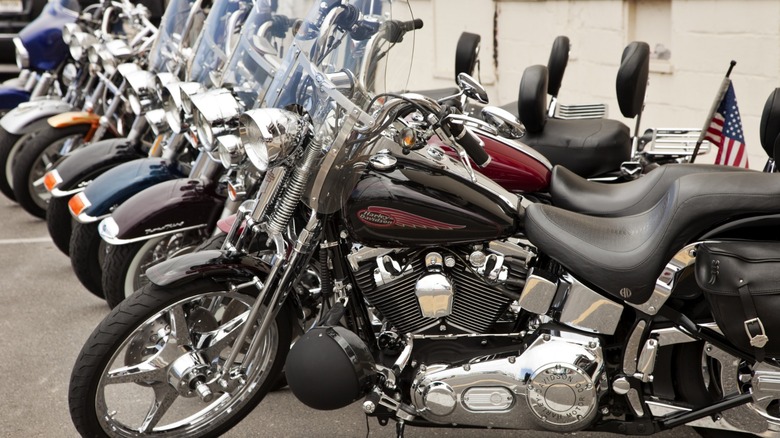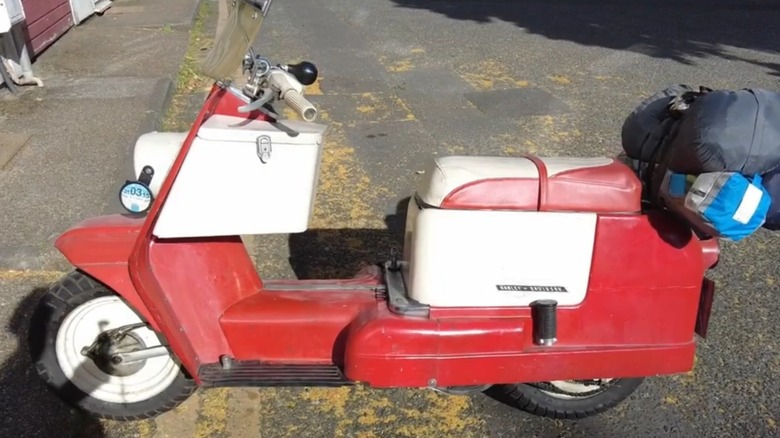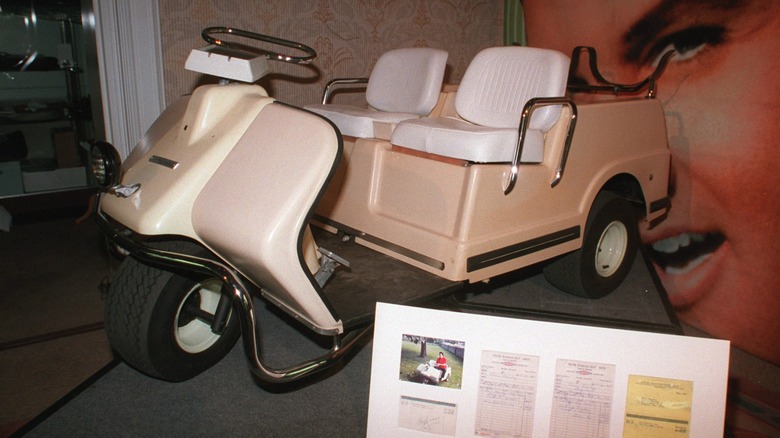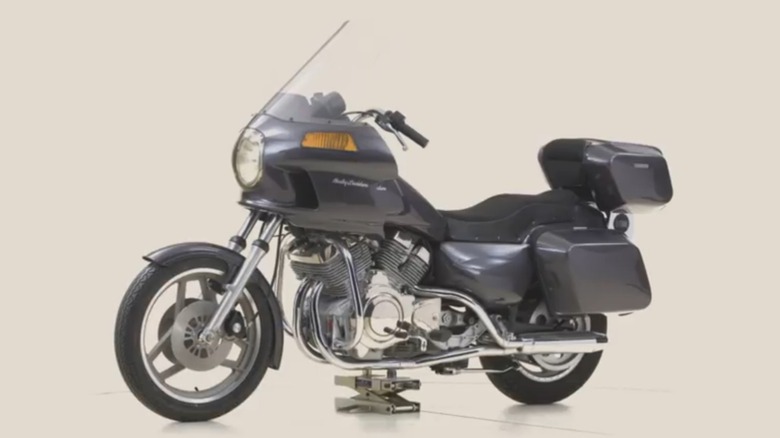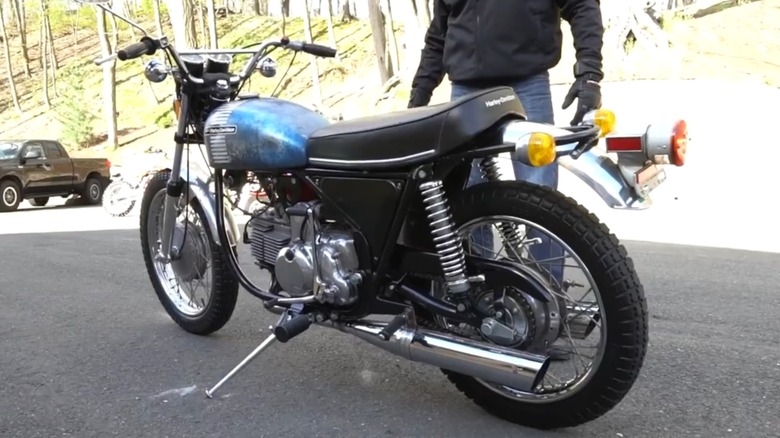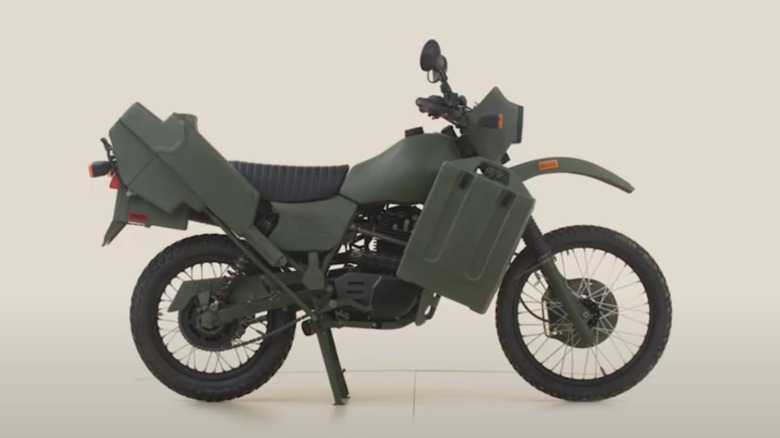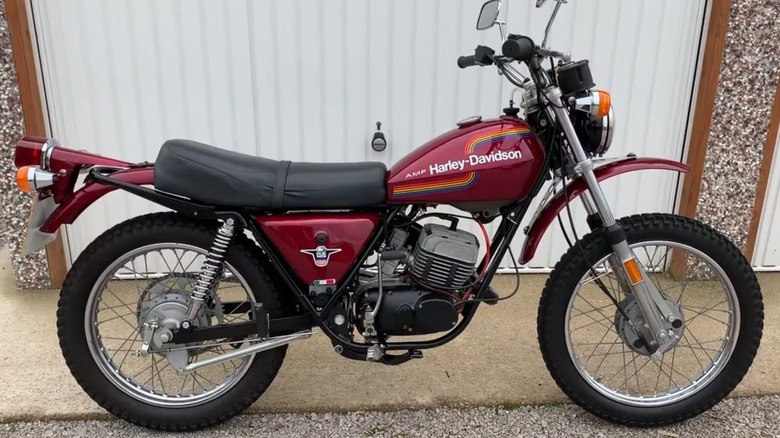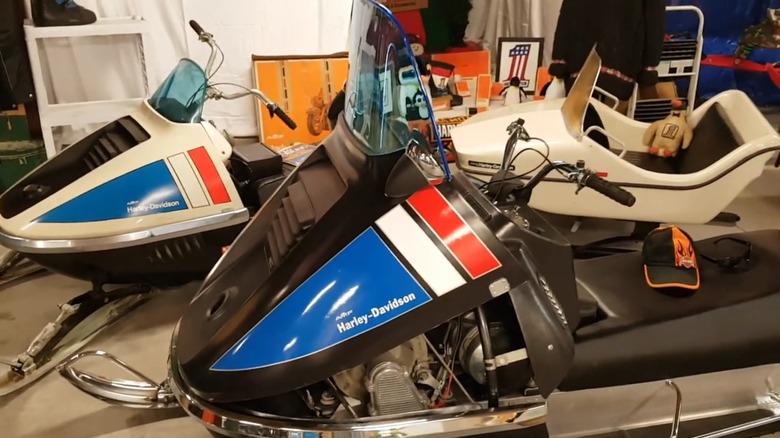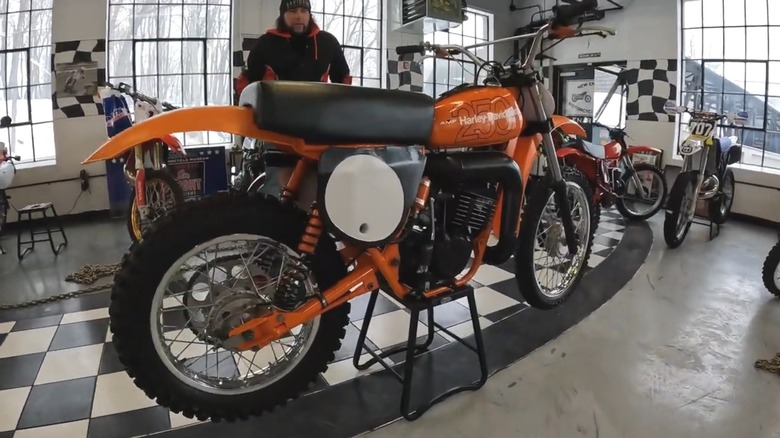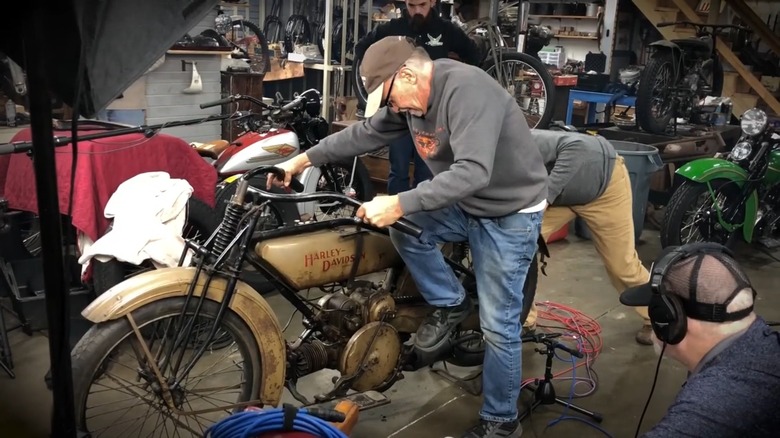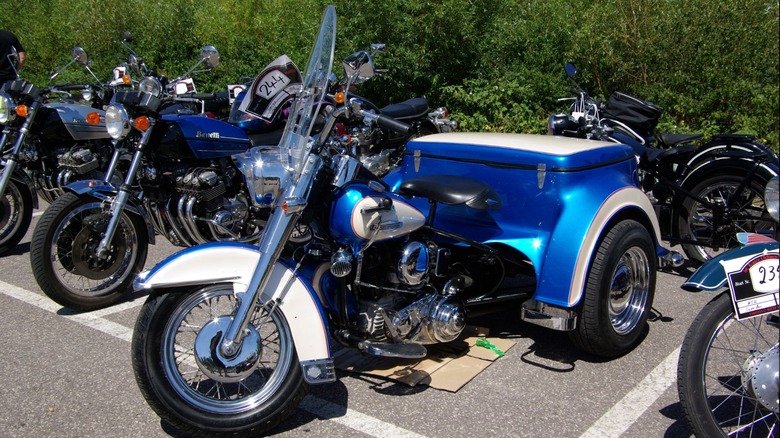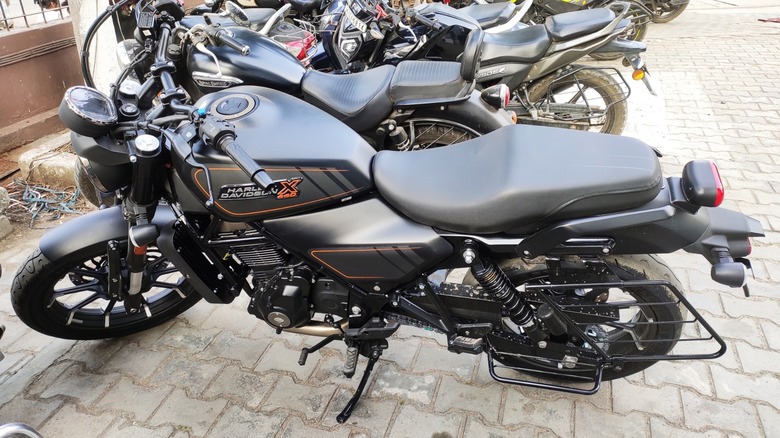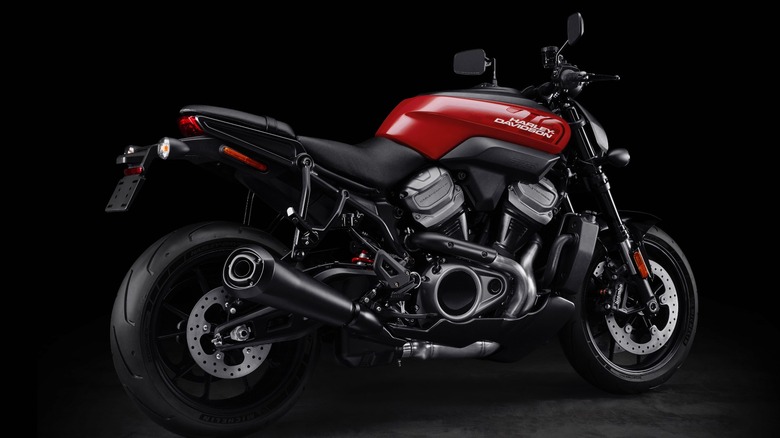12 Harley-Davidson Models You Didn't Realize Existed
For 121 years, Milwaukee, Wisconsin has been the home of America's most recognizable motorcycle brand, Harley-Davidson. While its early years were shaped by trial and error in creating engines and frames of what was barely removed from being a motorized bicycle, it would eventually settle on building primarily large bikes around longitudinally-mounted v-twin engines. These have shaped both the engineering and design of Harley-Davidson models for decades, and the rumble of the v-twin with a continuous heritage styling each mark a Harley-Davidson motorcycle as an icon of the American road.
Like any other major manufacturer, especially one that has experienced multiple ups and downs through the years, Harley-Davidson has sought to remain relevant as well as profitable and to do so, recognized that expanding its product offerings can bring in new buyers. With a few exploits into different market segments and a couple of different markets altogether, Harley's history is replete with oddball machines skewing from the chrome laden v-twins America is so accustomed to. Some of the peculiarities are likely to be known by the full-on Harley fans, but you may not have known the below Harleys ever existed.
Harley-Davidson Topper
By the end of the 1950s, Harley-Davidson was in a good financial position and saw opportunities to expand its business into new markets. This was also a time when motor scooters proliferated throughout the country, coming from both domestic makers such as Cushman and Salisbury and import makers like Vespa and Lambretta. As part of the spoils of war from WWII, Harley received rights to a German DKW 125cc engine which it later enlarged to 165cc. This engine formed the basis for an original motor scooter design from Harley-Davidson called the Topper.
Featuring a step-through design with a frame, footboard, leg shield, and fender made from metal, the Topper housed its horizontal 2-stroke 165cc single under a fiberglass housing upon which the rider sat. The engine was started with a pull rope, which was chosen because Harley thought owners would be familiar with it from their lawn mowers. A front hand brake and rear foot brake handled stopping, and gearing was handled by a continuously variable transmission, a rare feature for the time that is now commonplace, for simple twist-and-go scootering.
The Topper lasted from 1961 to 1965, with production ending at the same time as Cushman, its closest American competition — small bikes from Japan pilfered sales from both companies. An estimated 3,000 Toppers were built by Harley, making them a rarity and a Harley-Davidson curiosity today. Unlike some rare Hogs, Toppers go for around $5,000 today, although you are unlikely to gain any street cred.
Harley-Davidson Golf Cart
At about the same time Harley-Davidson branched out into the motor scooter market, the early '60s, it also branched out into another wildly divergent market with a new and original product, a golf cart. Harley-Davidson built golf carts using its own original design, and they initially came only in three-wheel versions, with a fourth wheel added many years later. These carts proved to be far more successful than the short-lived Topper, continuing in production until the 1980s.
Harley initially built all of its carts with a 2-stroke 250cc gasoline engine and added electric versions in 1969. The gas-powered versions feature a quirk of engineering when moving in reverse. Rather than adding a reverse gear, the driver had to shut off the engine, flip a switch, and restart it. The starter motor would spin in the opposite direction and run the engine backwards to back up, as 2-strokes can run in either direction. Mounted centrally behind the front wheel was a tiller/steering bar, which was swapped for a more traditional steering wheel after four-wheeled models were added.
Harley successfully sold these carts through the AMF era after American Foundry bought the company. The golf cart division was sold to Columbia Par Car in 1980, and the production of Harley-Davidson carts soon came to a close. Today, they are highly collectible and fully restored and custom models can sell for thousands.
Harley-Davidson Nova
Harley-Davidson is associated with motorcycles powered by the classic American air-cooled v-twin engine, but there was a time in which that status quo could have changed. Long squirreled away into the recesses of Harley's storage facilities was a project the company embarked upon in the early '80s and then killed and kept quiet for 25 years.
Developed surrounded by complete secrecy, Harley-Davidson enlisted Porsche for help with engineering a new engine, which resulted in a water-cooled V4 with impressive specifications and scalability such that it was slated for a range of v-twin, V4, and V6 models up to 1500cc. The compact 60-degree v-angle made for a compact engine and a counter-rotating balance shaft allowed the engine to become a stressed member of the frame. The radiator was tucked up under the seat, providing for clean lines and an open and sporting look. This Harley-Davison would have rewritten the entire playbook and introduced an American motorcycle, the Nova, as advanced as anything from Japan or Europe. However, it was not to be.
Despite being a nearly fully developed project with a tentative launch date in 1981, a change in ownership and need to reallocate resources of a financially burdened Harley-Davidson ultimately sealed the Nova's fate. Ultimately, the investment in quality control and a new v-twin engine paid off and sent Harley to reach new heights and become the stable and independent company it is today. Harley later rekindled the Porsche relationship when it co-developed the boundary-pushing V-rod in 2002.
Harley-Davidson Sprint SS350
Italian airplane manufacturer Aermacchi sought to reinvent itself after WWII with motorcycle production. It found middling success with its early models, but less than a decade after it began, Harley-Davison bought a controlling share of the company, marking the start of a long and productive relationship.
Buying into Aermacchi allowed Harley to quickly introduce models to meet a rising demand for smaller bikes. At the time of the purchase, Aermacchi produced a well-designed bike with a robust 250cc engine called the Ala Verda, which was renamed the Sprint and became the first Aermacchi Harley-Davidson put on sale in the United States.
The Italian-built Sprint was not necessarily warmly received by established Harley dealers upon its introduction, but it continued to be offered nonetheless. Regardless of the sales figures, the Sprint found success when put on the track, making a name for itself in several racing classes. With several wins under its belt, the Sprint's 250cc engine was enlarged to 350cc in response to Japanese competition and became known as the Sprint SS350. Despite being born Italian, Cycle World in 1968 noted the striking resemblance of the SS350 to Harley's popular Sportster line and otherwise praised the bike for its many clever features and good riding characteristics.
Harley-Davidson MT500
One of the most important Harley-Davidson motorcycles ever made was the WLA, a military model deployed during WWII. Harleys were also used in WWI, but the 20,000 Series J copies sent to Europe were just a fraction of the 80,000 WLAs sent the second time around. As the Cold War set in, military tactics changed and battlefields saw little use for motorcycles as other types of transport dominated. This left Harley largely out of the defense industry for decades, but in the 1980s, it built one more bike for the Department of Defense, the MT500.
To say that Harley developed this bike would not be wholly accurate. The new soldier cycle came from a British Armstrong design, itself a derivative of an Italian SWM design, powered by an Austrian Rotax engine. While the WLA was essentially a modified version of its street bike, the new MT500 was a dual-sport machine made for tackling the inconsistent terrain of conflict. The 500cc Rotax engine supplied 32 horsepower with predictable reliability, and the exterior paint and plastics, including a rifle mount and supply box, all came in olive green.
While Harley built and sold some units, production was extremely limited, with estimates of about 500 produced. It was meant to be a good option to airdrop into a location for special operations, but late '80s military changes ultimately killed the program. Since the Rotax burns gasoline, prospects for a huge contract diminished as NATO moved toward a diesel-fuel-only policy.
Harley-Davidson SXT125
Walk into a Harley-Davidson dealership today and ask a salesperson to show you their trail bikes and you'll be sure to receive a blank stare. Trail bikes are the domain of the Japanese. But transport yourself back to the mid-'70s and you will be shown a shiny new Harley-Davidson SXT125, among other similar models.
The complete name of this machine is AMF Harley-Davidson Aermacchi SXT125, and it was an Italian-built bike of high quality that held its own against the competition of the day. Its specs are typical of trail bikes of the era, which include the 2-stroke 125cc engine fed by a Dell'Orto carburetor with Mikuni oil pump, 5-speed transmission, full lighting, speedometer, and the ability for legal road use.
Not much more has been written about this bike, likely because it is not a big v-twin and old trail bikes rarely see magazine centerfolds. Yet, it was very much a Harley-Davidson product from 1975 to 1978, which means it was among the last of the Aermacchi machines.
Harley-Davidson Y 400
Throughout the '60s and '70s, Harley-Davidson dabbled in several markets to diversify its customer base from its core v-twin motorcycle customers. This included scooters and golf carts, and a trip to Italy brought an entire motorcycle company home to Wisconsin. But during the AMF ownership period, Harley even produced a snowmobile.
When AMF bought Harley, it brought an already existing snowmobile business with it, although its models were plagued with quality issues. Interestingly, Harley management was already considering snowmobile production but lacked resources. With AMF backing, Harley developed a new model that entered production in 1972. The AMF Harley-Davidson Y 400 came powered by a 400cc Aermacchi engine and included several innovative features, including dampened skis to aid with stability. However, performance lacked, it had no storage, and noise and vibration were unacceptably high.
Ultimately, the Y 400 lasted four years. It makes sense that a Wisconsin company would build a snowmobile, but today, it makes more sense that Harley-Davidson just builds Harley-Davidsons.
Harley-Davidson MX250
The '70s were a heyday for motocross, and it seems that dozens of manufacturers were working to get their bike to the front of the pack around every track in the country. Aside from the Big Four Japanese makers were several European brands along with Hodaka, a joint American-Japanese dirt bike producer, and Harley-Davidson. The Aermacchi-built Harley-Davidson dirt bike was the MX250, and it arrived in dealers to tackle the motocross market but failed to make much of a mark on it.
The MX250 started as hand-built prototypes produced in Milwaukee in the company's race department and were offered to dealers, but none accepted. A year later, in 1977, Harley imposed regular production models from Italy on its dealer network regardless of whether they wanted to sell them. With such an inauspicious start, it should be no surprise that they failed to sell. In all, it is estimated about 900 were produced and few were sold.
Harley-Davidson Sport
From the day Harley-Davidson first introduced it, the v-twin engine has been a staple of its products and defined the company throughout the decades. The v-twin was introduced in 1909, and just about 10 years later, Harley introduced a second twin, though it would have less staying power.
The Harley-Davidson W, introduced in 1919, was also called the Sport, and it featured a horizontally-opposed twin mounted longitudinally to the frame. For a mere $335, later dropped to $275, one could have a 600cc Harley-Davidson full of innovative features. The engine was a stressed member of the frame, used a large external flywheel, drove the wheel with an enclosed chain bathed in oil, and a manifold that served both intake and exhaust strokes. And all of this only weighed 257 pounds.
The lightweight and clever Sport performed well, even becoming the first motorcycle to top Pike's Peak. Clearly it was a clever machine, but it failed to gain traction with American buyers — Harley even marketed it towards women. While it sold much better in Europe, where smaller machines were more popular, something which holds true today, production ended in 1923 with a total production of about 10,000 units.
Harley-Davidson Servi-car
The Harley-Davidson Sportster has been in production for 67 years, making it one of its most successful models, but there is an earlier model that comes in at a close second with 50 years of production, the Servi-car. The range of trikes that Harley currently offers may be modern motorcycles fully equipped all with the latest technology, but they have deep roots within the company that stretch back to its early days. Introduced in 1923, the Servi-car provided buyers a compact and economical utility transport perfect for small deliveries in congested city centers.
Initial production of the Servi-car used the R-series side-valve engine on a frame tubular frame with a sub-frame holding a rear axle driving two wheels. Atop the axle was a sizable cargo box, and the rest of the trike was completed mostly with off-the-shelf Harley parts. It was meant to be possible for drivers with no experience on two wheels to easily adapt to the three-wheeler — the foot brake and three-speed shift lever should have provided some familiarity for car drivers.
The applications for Servi-cars are countless. They were used for everything from police patrol to ice cream sales, but were commonly used for service departments that would deliver customer cars home with a Servi-car in tow to be used by the driver to return to the shop. Production ended in 1973, and existing models can be extremely valuable, such as a 1949 Police Servi-car sold by Sotheby's in 2020, which went for $54,000.
Harley-Davidson X440
Harley has a 20-year history of selling bikes built in a foreign country, Italy, to market models to Americans seeking smaller alternatives to the big cruisers it sold at the time. Today, the company is doing something similar but with key differences. However, Harley has a partner rather than a subsidiary, and its partner is in India.
Harley-Davidson began assembling motorcycles in the country in 2011, and the need for a smaller model resulted in the introduction of the Street 500 and 750. Harley officially exited the country in 2020 but almost immediately set up Hero MotoCorp as a distributor in its absence. Hero received rights to import and sell Harley-Davidson models along with rights to develop and build smaller models for the local market. The first Indian-built machine is the X440.
With a single-cylinder air-cooled 440cc engine and modern styling reminiscent of a Universal Japanese Motorcycle, the X440 is a nicely packaged small bike perfectly suited to the tastes of Indian buyers. As Hero is the second-best-selling motorcycle in the world, Harley is likely in good hands.
Harley-Davidson Bronx
Originally teased by Harley-Davidson in 2019 with production slated for 2021, the arrival of a Harley sport bike poised to take on the likes of Yamaha, Suzuki, and Ducati was welcome news for Americans wanting to buy a domestic bike with less flair and more thrill. However, as of 2024, the bike that would be called Bronx is conspicuously absent from Harley's official website and any official future product releases.
Built around the water-cooled Revolution Max v-twin, the Bronx would be the first full-fledged sport bike since Harley closed down its Buell division in 2009. This time, should it ever come to fruition, Harley would have a cutting-edge top speed machine with its v-twin tuned for maximum power over its traditional low-end torque. While it was only ever a concept, the Bronx exists and Harley released promotional videos of it and displayed it at various shows. But then it went dark.
According to RevZilla, the chances of getting this in showrooms now is basically nil. A new CEO in 2020 changed strategies that had previously been set to draw new buyers to the brand to efforts that make more profit per bike, and the Bronx was most likely never going to turn a profit. Therefore, for the foreseeable future, Harley vs Hayabusa showdowns seem unlikely, but we can still hold onto that dream for now.
